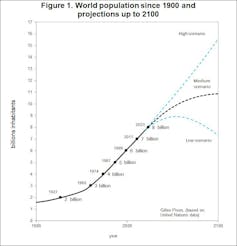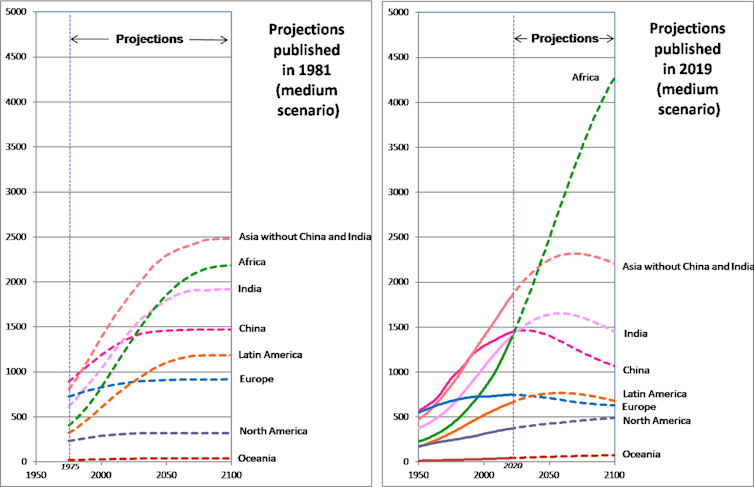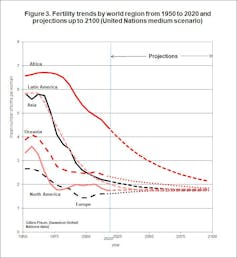In 2019 the planet has 7.7 billion inhabitants, which is likely to rise to 8.5 billion in 2030 and nearly 10 billion in 2050. These figures are taken from the world population projections just released by the United Nations.
They correspond to the medium scenario in which fertility, which is 2.5 children per woman today worldwide and decreases year by year, continues to decline to 2.2 children in 2050 and 1.9 in 2100. Under the high scenario, fertility declines less rapidly, with a level of 0.5 children above the medium scenario, and the world population would reach 10.6 billion by 2050. In the low scenario, it decreases faster and is 0.5 children below the medium scenario, with the population reaching only 8.9 billion by 2050. Extending the projections leads to 10.9 billion inhabitants in 2100 in the medium scenario and, respectively, 16 and 7 billion in the high and low scenarios (Figure 1).

3% fewer people in 2100 than projected two years ago
These new projections replace those that the United Nations published in 2017. The calculations have been revised upwards or downwards according to the countries or regions. For example, in the medium scenario, the figure for China in 2100 is 44 million higher than that in the 2017 projections (4% more). In contrast, for India, it is down 66 million (4% less). The same goes for Africa as a whole, whose projected population in 2100 is reduced by 187 million (-4%). For the planet as a whole, the upward and downward revisions offset each other, but only partly. According to the medium scenario, the global total for 2050 is projected to be 37 million fewer people than in the previous projections (-0.4%) and 309 million fewer in 2100 (-3%).
The UN revises its population projections every two years. Like those just released, the changes from the projections released two years earlier look small. But when accumulated over several decades, they become significant.
Projections have changed a lot in 40 years
The first time the United Nations published population projections up to 2100 was in 1981, and their medium scenario predicted then that the world population would reach 10.5 billion that year. The June 2019 projections suggest a figure of 10.9 billion – 0.4 billion higher. While the world total is slightly higher, it conceals a radical change in population distribution across the different continents. In 1981, the population of Asia was projected to reach 5.9 billion by 2100, but in 2019 the figure was revised downward to 4.7 billion (20% less). Likewise, for Latin America, the figure of 1,187 million in 2100 was lowered to 680 million (a decrease of about 43%). For Africa, on the other hand, the 1981 projections were 2.2 billion for 2100, while the 2019 projections have nearly doubled this figure to 4.3 billion (see Figure 2 below).

Mortality has declined more than expected
Where do these changes come from? The population of a country or continent changes because of fertility and mortality. Migration is also a factor, but to a lesser extent for many countries and with zero effect worldwide. It is therefore the assumptions on mortality and fertility that affect projections. For mortality, it declined faster than imagined 40 years ago, especially for children, which led to more rapid growth. The AIDS epidemic was certainly not anticipated at the time, and Africa has paid the heaviest cost. But the excess mortality it has caused will have lasted only one-time, and life expectancy has begun to increase again in recent years and relatively quickly. AIDS has had little effect on the demographic vitality of Africa.
The changes in assumptions that ultimately had the larger effect on the projections are those concerning fertility, the evolution of which was revised following various surprises.
Replacement of generations?
Nearly 40 years ago, the UN’s medium scenario population projections were based on future fertility of close to 2.1 children per woman everywhere in the world. In countries already below this – like most industrialized countries – it was forecast to rise incrementally to 2.1, then flatten out. In higher fertility countries, it was projected to fall to 2.1 and then level off.
This threshold corresponds to the replacement of generations – each couple is replaced on average by two children becoming adults themselves – and choosing it as the level of convergence assumes a long-term stabilization of the world’s population as well as that of each region composing it. Hence, in the 1981 projections, each region’s or country’s population curve plateaus once the growth phase has ended (Figure 2 above).
The evolution of fertility
However, the observed fertility trends were different and the scenarios had to be revised to take into account several surprises.
First surprise: fertility has remained well below 2.1 children in many industrialized countries. And many Southern countries have joined the countries of the North in low fertility. Consequently, the United Nations has abandoned its hypothesis of convergence to 2.1 children to adopt a convergence level well below: 1.85 children (Figure 3 below). The population curves then has a bell-like shape almost everywhere: after reaching a maximum, the population decreases (Figure 2 above).

The second surprise came 30 years ago, when surveys revealed the unexpectedly rapid pace of fertility decline in many countries of Asia and Latin America. In response to this new trend, the United Nations made substantial downward revisions to their demographic projections for these continents.
A third, more recent surprise concerns intertropical Africa. Fertility decline in this region was expected to begin later than in Asia and Latin America due to slower social and economic development, but it was assumed that the rate of decrease would be similar to that assumed for other regions of the Global South.
This is indeed the case in North and Southern Africa but not in intertropical Africa, where the fertility decline is occurring more slowly. This explains the upward revision of projections for Africa, which could be home to more than a third of the world’s population by 2100.
These figures are projections, and the future is not written. However, demographic projections are quite reliable for predicting population size in the short-term future, i.e., over periods of 10, 20 or 30 years. As for more distant projections, they will undoubtedly be revised following the surprises that the future holds for us.


